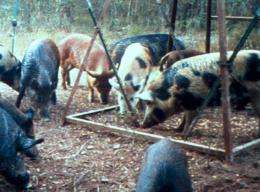New publication explains how feral hogs negatively affect native plants

Not only do feral hogs cause harm to crops and landscaping, they also inflict significant damage upon native plant communities, according to a new Texas AgriLife Extension Service publication.
“Feral hogs root pastures and grasslands, consume native vegetation and have a negative impact on water quality,” said Jared Timmons, AgriLife Extension wildlife assistant and one of the authors of “Feral Hogs Negatively Affect Native Plant Communities.”
“They cause significant ecological damage by their rooting, which turns over soil and damages native plant communities, possibly leading to greater erosion,” he said.
To educate people on the ramifications of this additional damage and what can be done to mitigate it, he and other AgriLife Extension and Texas A&M University System experts wrote the 10-page publication, Timmons said.
“It was originally produced in conjunction with efforts relating to improving water quality in the Plum Creek watershed, but the information and principles apply to forest and riparian areas throughout Texas,” he said.
Timmons said he and the other authors were indebted to researchers from Rice University and Texas A&M University who conducted a study in the Big Thicket National Preserve that was cited in their publication.
“Researchers used fences to exclude feral hogs from some areas of the preserve while leaving other areas unfenced to allow them access,” Timmons said. “They discovered that fenced plots had more large-seeded trees such as oaks, less non-native tree species and higher plant diversity.”
Timmons said such study results can be explained by the disturbance created by feral hogs and consumption of native large seeds such as acorns and nuts, therefore allowing non-native species a chance to invade.
“Non-native feral hogs also compete with native wildlife to consume these seeds and this may produce a disproportionate effect on seed abundance and future tree population,” Timmons said. “This can have a negative effect on riparian areas that consist of native grasses, forbs, shrubs and largely of trees such as oaks and hickories.”
“Corral traps are very effective in trapping large numbers of feral hogs at one time,” said Blake Alldredge, AgriLife Extension wildlife associate and publication co-author. “Snaring or hunting may also be necessary to reduce feral hog numbers.”
Alldredge added that excluding hogs from environmentally sensitive areas such as riparian forests will allow the soil to remain undisturbed by feral hogs and allow new saplings to establish and grow.
Timmons said riparian areas provide many positive “ecosystem services” that benefit humans, including floodwater retention, groundwater recharge, water filtration, erosion protection, wildlife habitat, and providing for greater recreational and timber-production opportunities. He noted that excluding feral hogs from these areas increased the diversity and survival rate of native tree species, adding that study data showed large-seeded-species saplings were more than twice as abundant in areas where feral hogs were excluded.
“High plant diversity is important in every ecosystem as it helps increase ecosystem productivity, provides a buffer from floods and other natural disasters and supports numerous species of wildlife,” he said.
The publication may be downloaded from the Texas AgriLife Bookstore website at agrilifebookstore.org or from the Plum Creek Watershed Partnership website at pcwp.tamu.edu/feral-hogs/ . Other materials on feral hogs and feral hog management may be found on both websites.
The partnership website also has voice-over presentations and a feral hog reporting website, where landowners may report feral hog activity, including removal, and the general public may report feral hog sightings, Timmons said.
Provided by Texas A&M AgriLife
















